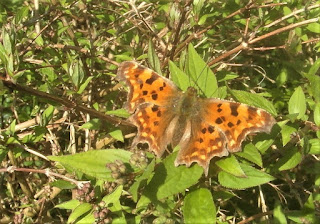This blog may help people explore some of the 'hidden' issues involved in certain media treatments of environmental and scientific issues. Using personal digital images, it's also intended to emphasise seasonal (and other) changes in natural history of the Swansea (South Wales) area. The material should help participants in field-based modules and people generally interested in the natural world. The views are wholly those of the author.
Friday, 31 March 2017
Thursday, 30 March 2017
Tuesday, 28 March 2017
Monday, 27 March 2017
Saturday, 25 March 2017
Friday, 24 March 2017
Tuesday, 21 March 2017
Bite of the Spider Woman?
Interesting news that a non-toxic factor (designated Hi 1a) in the venom of an Australian funnel web spider (whose bite can kill a human in 15 minutes) has been shown, in rats, to protect brain cells even if given several hours after a stroke (https://www.theguardian.com/science/2017/mar/20/deadly-spider-venom-could-ward-off-stroke-brain-damage-say-doctors-funnel-web). Patients would need a rapid brain scan before being given Hi 1a to ensure the stroke was caused by a thrombosis (clot) as the factor encourages bleeding. It seems that, in a stroke, brain cells are generally killed by being starved of oxygen (by the cutting off of the blood supply) so that they engage in anaerobic glycolysis (the breaking down of glucose into pyruvate), ultimately, in the absence of oxygen, generating toxic lactic acid (as in a sprinter's leg muscles). The spider factor prevents anaerobic glycolysis and should reduce the brain damage caused by the stroke. Many venoms (from snakes as well as spiders) appear to have medically or scientifically important properties.
Sugar Babes?
Worrying news that there has been, over the last 10 years, a 25% rise in UK children under the age of 4 having to have their milk teeth extracted due to sugar-related decay (https://www.theguardian.com/society/2017/mar/21/tooth-extractions-rise-among-under-fours). Although the milk teeth are replaced by the adult set, the decay doesn't auger well for the survival of any teeth. It further suggests that the diet is likely to further encourage obesity and the onset of type 2 diabetes. It does seem appropriate to put more effort into encouraging a reduced intake of sugars and improved dental hygiene.
Monday, 20 March 2017
Sunday, 19 March 2017
Daffy for Dementia?
With more than 800k sufferers of dementia in the UK (and likely to grow with an ageing population), there is much interest in potential treatments (especially of the early stages). An interesting development (jncc.defra.gov.uk/page-5721) is the observation that a natural product (Galantamine) in the bulbs and leaves of the Daffodil (Narcissus pseudonarcissus) and the Snowdrop (Galanthus nivalis) appears to have beneficial effects on the development of Alzheimer's. Like any other 'herbal drug', the chemical is synthesised by the plant to protect the valuable bulb rather than for our benefit! It appears that bulbs grown at altitude in the Black Mountains produce higher levels of Galantamine (and even there it takes 10 tons of bulbs to generate 1kg of the chemical). It would make a change from sheep farming!
Saturday, 18 March 2017
I Got the (Large) Blues
A former Bristol bodybuilder has reportedly been found guilty of capturing, killing and mounting Large blue butterflies taken from 2 reintroduction sites in Daneway Banks and Collard Hill (www.telegraph.co.uk/news/2017/03/16/collector-captured-killed-specimens-uks-rarest-butterfly-court/). The butterfly was driven to extinction in the UK before attempts were made to reintroduce it. This was made much more difficult by the prices that people can charge for specimens disguised to look like (legal) Victorian exhibits. Apparently, the accused claiming that he was trying to catch parasitic wasps with a shrimping net in the 2 locations and that his butterfly specimens were obtained from overseas did not convince.
C.O.D.
News that the Marine Conservation Society has removed haddock caught in 3 North Sea and west of Scotland locations from the sustainable seafood list (www.bbc.co.uk/news/uk-scotland-39293265). Other haddock populations still make the list. This has, predictably, not gone down well with fishermen (largely based in Peterhead) but is a consequence of the haddock populations of potential breeding age declining below acceptable levels in the 3 specified areas. This might be bad news for cod whose levels in these areas have increased, making it an acceptable replacement species.
Friday, 17 March 2017
Monday, 13 March 2017
Sunday, 12 March 2017
Friday, 10 March 2017
Itchy Feat?
Some interesting studies on 'contagious scratching' have been made using mice at Washington University (https://www.sciencenews.org/article/scratching-catching-mice?tgt=nr). Their animals started scratching when housed with a scratching conspecific but did not respond in this way when paired with a non-scratcher. Even more remarkably (given that their vision is not good), the mice started scratching when viewing a video-recording of a scratching mouse. The scientists suggested that scratching is 'hard-wired' in the brain establishing a role for a brain area called the suprachiasmatic nucleus and gastrin releasing peptide (mice without the ability to manufacture this peptide showed little scratching but the activity was induced by injecting the hormone). It was suggested that scratching was a potential defence against disease. Whilst there is no absolute reason why 'contagious scratching' should be controlled by precisely the same mechanism in primates (including ourselves), the study does raise several lines for investigation
Horn of Plenty?
Disturbing news that 'poachers' have killed a young male rhinoceros ('Vince') in a zoo at Thoiry, west of Paris and removed one of its horns with a chainsaw (https://www.theguardian.com/world/2017/mar/07/rhino-shot-dead-by-poachers-at-french-zoo). It seems likely that the criminals involved (possibly disturbed or suffering an equipment fault before removing the second horn) were intent on selling the horn to the Chinese 'alternative medicine' fraternity where such rare items can generate very high prices (in spite of there being no evidence that the materials are curative). This is a very worrying development as one might have expected animals to be safe from poachers in such a location.
Sunday, 5 March 2017
Saturday, 4 March 2017
Pools in the Pool
Studies on 2 public swimming pools in Canada have recorded the amount of the artificial sweetener acesulfame potassium that is present in many foods and is passed unchanged through the body to be voided in the urine (https://www.theguardian.com/science/2017/mar/01/how-much-pee-is-in-our-swimming-pools-new-urine-test-reveals-the-truth). The workers conducting this study have estimated that, over a 3 week period, the swimming pools of around 830,000 litres each received about 75 litres of pee (equivalent to a dustbin full). They have also recorded substantial quantities of urine in hot-tubs. It appears that you get really close to your neighbours in these locations!
Zoo Holocaust?
I must admit to having a somewhat ambivalent attitude to zoos. I certainly prefer to look at organisms (plants and fungi as well as animals) in their natural worlds. Having said that, well run zoos with lots of environmental enrichment do boost enthusiasm (and support?) for animals in a way that TV programmes cannot do; do enable people to experience some impressive beasts without incurring an enormous carbon footprint and sometimes do good work with captive breeding programmes to maintain endangered species (although these are not always very successful). Reports, however, that a Cumbrian zoo had almost 500 mortalities in its 1500 animal stock over a 4 year period are deeply concerning (www.independent.co.uk/news/uk/home-news/cumbria-zoo-lose-licence-south-lakes-safari-486-animals-die-four-years-tiget-mauls-keeper-death-2014-97605761.html). This is especially so in an establishment that had a keeper mauled to death by a tiger because of reportedly faulty working practices. I am unsurprised that their licence to operate is being reconsidered.
Supplementing Your Way to Health?
People sometimes suggest that animal experiments have little direct relevance to human health but a study with mice may be helpful in dealing with the growing concerns about the effects of air pollution, especially on children in London schools (https://www.theguardian.com/environment/2017/mar/03/oil-supplements-could-tackle-harmful-health-effects-of-air-pollution). The study suggests that adding omega 3 oils (in oily fish and flax oil etc) to the mouse diets can reduce the lung damage caused by oxidative stress by between 30 and 50%. It has been known for some time that air pollution (including a simply occluding the sun?) reduces vitamin D levels in people. If the studies are confirmed, perhaps the authorities should consider offering free vitamin supplementation (as getting all to eat mackerel may be difficult) to people forced to live or study in areas of high pollution (so long as they continue with attempts to reduce actual pollution levels)?
Subscribe to:
Comments (Atom)
-
I n the UK and US, a pparently popular and successful vegan/vegetarian restaurants are reportedly closing or adding meat to their menus ( ...
-
Early ripening fruit may seem convenient but some folk think it confirms environmental stress. There's also a possibility th...
































%20mating%20NWCW.jpg)

